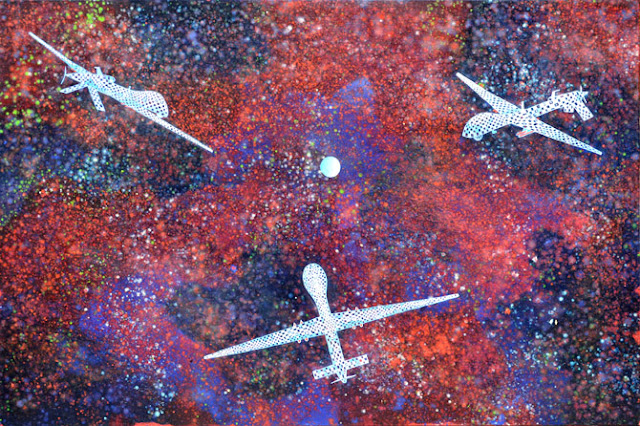Carl Sagan's description of Earth as a 'pale blue dot' was coined after seeing the photograph Voyager 1 took as it left the solar system, February 1990. On Sagan's suggestion the spacecraft's camera was turned back towards Earth. The image of Earth, identifiable as a pale blue dot, set among a myriad of other celestial entities had, and still has, a profound affect on people. The colour blue indicates an environment that can sustain life. Voyager 1's camera was turned off not long after the famous image was taken, to enable scientists to re-purpose computers. Sagan wrote a book called Pale Blue Dot in 1994. Voyager 1 is still travelling in interstellar space. Please visit this NASA website for more information.
In Pale Blue Dot: AKA Earth I have played with a scoping type perspective. It feels like Voyager 1 is falling back to Earth, maybe? Or, perhaps that we have been catapulted at speed away from Earth. The red flames around the pale blue dot, could represent the increasingly volatile nature of Earth's existence. They could also indicate some kind of renewal?
Regular readers will identify my play with a surveillance-like perspective, mimicking but also extending that of a militarised drone, a recurrent figure in some of my other recent paintings. Clearly, you and I, are well above or beyond the current reach of drones. Our 'surveillance' is far more sophisticated - it embraces imagination! The cosmic perspective 'reveals' the fiery threat-potential around Earth. Cosmologists, such as Lord Martin Rees suggest, that like at no other time in human history, the decisions we make now will affect whether life on Earth continues into the next centuries. A cosmic perspective reveals the kind of metaphoric precipice we now hover upon.
Cheers,
Kathryn
P.S. Please read another recent post Anomaly Detection with more paintings that represent the 'pale blue dot'
In Pale Blue Dot: AKA Earth I have played with a scoping type perspective. It feels like Voyager 1 is falling back to Earth, maybe? Or, perhaps that we have been catapulted at speed away from Earth. The red flames around the pale blue dot, could represent the increasingly volatile nature of Earth's existence. They could also indicate some kind of renewal?
Regular readers will identify my play with a surveillance-like perspective, mimicking but also extending that of a militarised drone, a recurrent figure in some of my other recent paintings. Clearly, you and I, are well above or beyond the current reach of drones. Our 'surveillance' is far more sophisticated - it embraces imagination! The cosmic perspective 'reveals' the fiery threat-potential around Earth. Cosmologists, such as Lord Martin Rees suggest, that like at no other time in human history, the decisions we make now will affect whether life on Earth continues into the next centuries. A cosmic perspective reveals the kind of metaphoric precipice we now hover upon.
Cheers,
Kathryn
P.S. Please read another recent post Anomaly Detection with more paintings that represent the 'pale blue dot'






